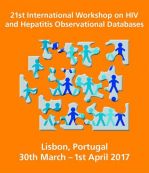Meeting report: SHM at IWHOD 2017

SHM researcher Ard van Sighem gave a presentation on the statistical model that he had previously developed in collaboration with the European Centre for Disease Prevention and Control (ECDC). This model uses HIV surveillance data to estimate the number of people who are living with HIV, but who are as yet undiagnosed. Last year, this method was applied to ATHENA data to estimate the number of undiagnosed HIV infections in the Netherlands. At IWHOD 2017, Ard presented an estimate of the number of undiagnosed HIV infections in Europe, based on data collected by the European Surveillance System (TESSy). From 2003 to 2015, 403,169 HIV diagnoses were made in Europe. In 2015, an estimated 120,100 (95% confidence interval [CI] 113,000-127,800) people had an as yet undiagnosed HIV infection, 47% of whom had a CD4 count ≥500 cells/mm3 and 31% of whom had a CD4 count <350 cells/mm3. Moreover, in 2015, there were an estimated 28,000 (95% CI 24,700-31,700) new HIV infections. The estimated number of undiagnosed HIV infections was highest in southern Europe. On the other hand, the number of new infections was highest in northern and western Europe, while the average time to diagnosis was shortest in these regions.
A second presentation by another SHM researcher, Sonia Boender, provided insight into the length of time that individuals on antiretroviral therapy (ART) remain on their first-line regimen. This involved a more detailed analysis of the findings previously reported in Chapter 2 (Response to cART) of SHM’s Monitoring Report 2016. During the period 2010-2015, there was a steady decrease in the percentage of individuals changing their first-line regimen within the first year due to toxicity. Although, until a few years ago, individuals who started their first-line regimen with a CD4 count above 500 cells/mm3 had a markedly higher risk of treatment interruptions and changes, this association has disappeared since the guidelines changed to recommend starting ART regardless of CD4 count.
SHM researcher Colette Smit presented data on differences between the 26 HIV treatment centres in the Netherlands (that also participate in ATHENA) in terms of the proportion of individuals actually starting first-line cART within 6 months after newly entering care. This analysis is based on work published in SHM’s latest Monitoring Report (Chapter 7, Quality of Care). The results showed a marked increase in the percentage of new patients starting ART within 6 months of entering care, from 62% in 2012 to 91% in 2014. Nonetheless, there remained considerable variation between treatment centres in terms of the group of individuals with a CD4 count greater than 500 cells/mm3. Overall, the likelihood of starting ART within 6 months of entering care was lowest in smaller centres (with fewer than 600 patients in care).
Another study that makes use of ATHENA data is the Comorbidity and Ageing with HIV (AGEhIV) cohort study. Maartje Dijkstra of the GGD Amsterdam gave a presentation on sexual dysfunction among homosexual and bisexual men included in the AGEhIV cohort, revealing that there was an independent association between being HIV-positive and having impaired sexual function, in particular erectile dysfunction.
In addition, data from the ATHENA cohort contributed to around 9 other presentations on international collaborations between HIV cohorts.
